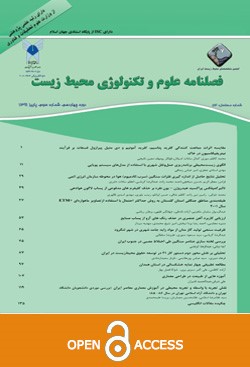حذف رنگ کاتیونی مالاشیت سبز از محلولهای آبی توسط مخلوط بیوپلیمر کاراگینان و سدیم آلژینات در حضور نانورس مونت موریلونیت
محورهای موضوعی : آب و محیط زیست
بهجت فرخی
1
,
نسیم ضیایی فر
2
*
![]() ,
حسین شیخلویی
3
,
حسین شیخلویی
3
1 - دانشجوی کارشناسی ارشد شیمی کاربردی، گروه شیمی، دانشگاه آزاد اسلامی واحد مراغه، مراغه، ایران
2 - استادیار شیمی کاربردی، گروه شیمی، دانشگاه آزاد اسلامی واحد مراغه، مراغه، ایران
3 - استادیار شیمی تجزیه، گروه شیمی، دانشگاه آزاد اسلامی واحد مراغه، مراغه، ایران
کلید واژه: سدیم آلژینات, پلیمر زیستی, حذف رنگ کاتیونی مالاشیت سبز, کاراگینان, سدیم مونتموریلونیت,
چکیده مقاله :
زمینه و هدف: رنگ کاتیونی مالاشیت سبز از جمله ترکیبات سمی مهم و حائز اهمیت در فاضلابهای صنعتی محسوب میشود. بهطور معمول از روشهای فیزیکوشیمیائی یا بیولوژیکی به منظور تصفیه آبهای حاوی غلظتهای بالای مالاشیت سبز استفاده میشود. در مطالعه حاضر ابتدا هیدروژل نانو کامپوزیتی بر پایه کاراگینان و سدیم آلژینات در حضور سدیم مونتموریلونیت به عنوان نانورس سنتز سپس برای مطالعه جذب مالاشیت سبز از نمونه های آبی مورد استفاده قرار گرفت. روش بررسی: آکریل آمید[1] به عنوان مونومر، متیلن بیس آکریل آمید[2] به عنوان شبکه ساز آلی و پتاسیم پر سولفات[3] به عنوان آغازگر مورد استفاده قرار گرفتند. برای بررسی خصوصیات هیدروژل بدست آمده از پراش اشعه ایکس[4]، میکروسکوپ الکترونی روبشی[5] و مادون قرمز تبدیل فوریه[6] استفاده گردید. در این مطالعه اثر پارامترهای تجزیهای مختلف نظیر pH، زمان تماس در حذف ماده رنگزا توسط هیدروژلهای نانو کامپوزیتی سنتز شده بررسی و شرایط بهینه حاصل گردید. یافته ها: با توجه به نتایج حاصل هیدروژلهای نانو کامپوزیتی سنتز شده به pH و تغییر مقدار کاراگینان و سدیم آلژینات حساس میباشند. زمان جذب تعادلی تعادلی 3 ساعت بدست آمد. ایزوترم جذب با مدل لانگمویر و سینتیک جذب با مدل سینتیک شبه درجه دوم مناسبتر تشخیص داده شد. بحث و نتیجه گیری: سرعت حذف رنگ مالاشیت با افزایش مقدار نانورس در محیط اسیدی افزایش می یابد. در نهایت می توان نتیجه گرفت که مخلوط پلیمر زیستی کاراگینان و سدیم آلژینات در حضور نانورس مونتموریلونیت جاذب مناسبی جهت حذف رنگ مالاشیت سبز از محلول های آبی است. 4- AAM 5- MBA 6- KPS 7- XRD 8- SEM 9- FTIR
Background and Objectives: Cationic dye malachite green is one of the most important toxic compounds in industrial wastewater. Typically, physicochemical or biological methods are used to water treatment and wastewater containing high concentrations of malachite green. In the present study nanocomposite hydrogels based on carrageenan and sodium alginate in the presence of sodium montmorillonite as Nano clay were synthesized and then used to study the absorption of malachite green from aqueous samples. Methods: Acrylamide was used as a monomer, methylene base acrylamide as an organic cross linker and potassium sulfate as an initiator. The adsorption of cationic dye malachite green by the nanocomposite hydrogels was investigated. The structures of nanocomposite hydrogels were investigated by (FTIR, XRD and SEM) techniques. The effect analytical parameters such as pH, contact time for the removal of dye material by synthesized nanocomposite hydrogels were investigated and optimal conditions were obtained. Finding: According to the results, synthesized nanocomposite hydrogels are sensitive to pH and changes in the amount of carrageenan and sodium alginate. Equilibrium absorption time is 3 hours. The absorption isotherm with Langmuir model and absorption kinetics was more suitable for pseudo-second order kinetic models. Discussion & Conclusion: The rate of removal of malachite green dye increases with increasing amount of Nano clay in the acidic medium. Finally, it can be concluded that the bio-polymer mixture of carrageenan and sodium alginate in the presence of sodium montmorillonite nanoclay is a suitable absorbent to remove the malachite green dye from aqueous solutions.
alumina reinforced polystyrene, Clean-Soil, Air, Water, Vol. 39, pp. 74-82
6. Po, R., 1994, Water-absorbent polymers, a patent survey, J.Macromol. Sci.-Rev. Macromol. Chem. Phys, C34, pp. 607-661.
10. Pourjavadi, A., Zohuriaan-Mehr, M.J., 2003, Superabsorbent hydrogels from starch-g-PAN: effect of some reaction on swelling behavior, J. Polym. Mater., Vol. 20, pp. 113-120.
_||_
alumina reinforced polystyrene, Clean-Soil, Air, Water, Vol. 39, pp. 74-82
6. Po, R., 1994, Water-absorbent polymers, a patent survey, J.Macromol. Sci.-Rev. Macromol. Chem. Phys, C34, pp. 607-661.
10. Pourjavadi, A., Zohuriaan-Mehr, M.J., 2003, Superabsorbent hydrogels from starch-g-PAN: effect of some reaction on swelling behavior, J. Polym. Mater., Vol. 20, pp. 113-120.

